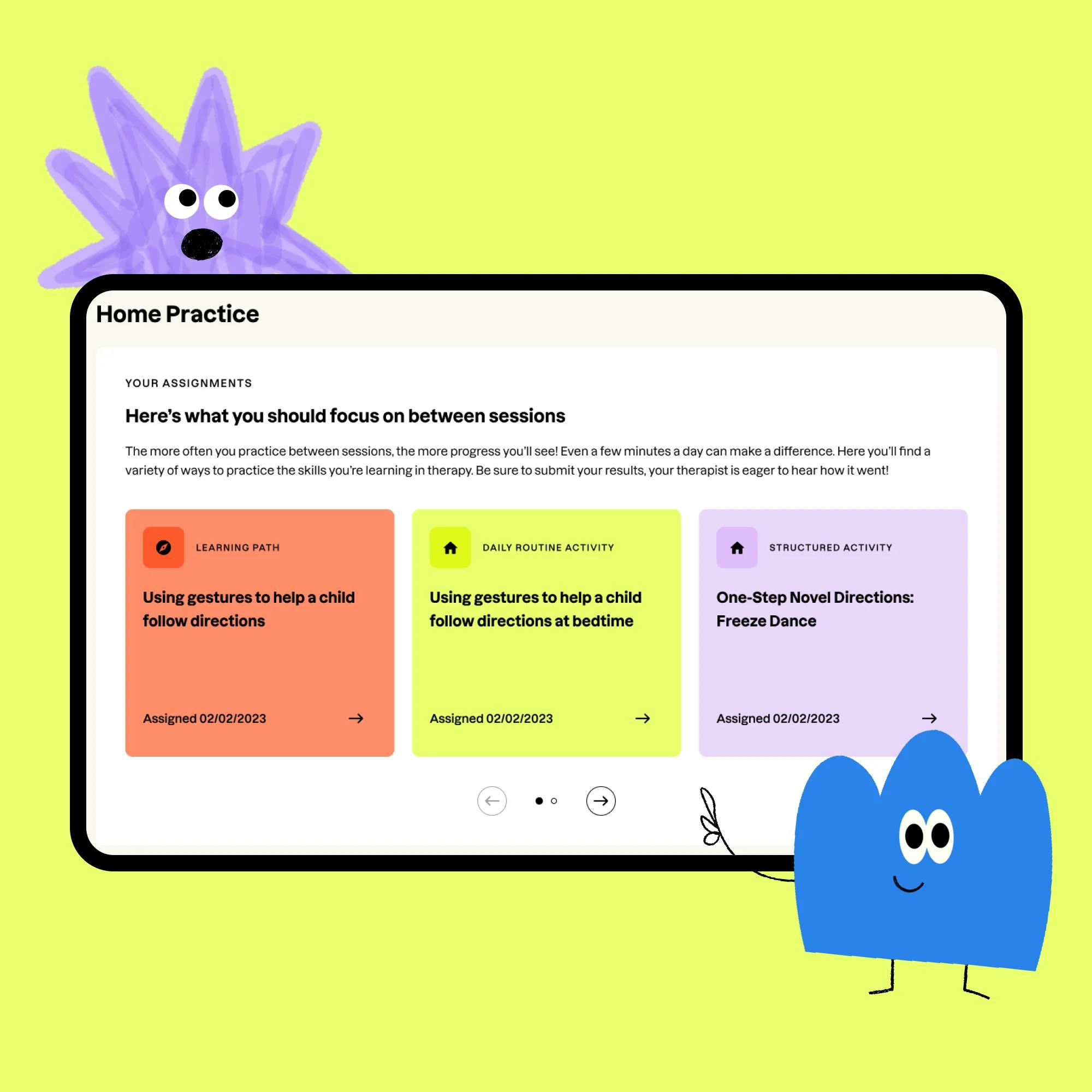
How to Fit Speech Practice into Your Daily Routine
 Abby Barnes, M.S., CCC-SLP
Abby Barnes, M.S., CCC-SLP
Sometimes it feels like parenting is all about reminding kids to do things. Pick up your toys, put your dishes in the sink, brush your teeth, finish your spelling homework. The thought of adding “practice your speech” might feel a little daunting. Plus, with all the demands of work, school, activities, and just everyday life, how can you make time for one. more. thing?
If your child is in speech therapy, their speech therapist should be recommending different types of practice to complete between sessions. Research shows that regular practice at home with a parent or caregiver is one of the best ways to see progress. But never fear: It’s easy to integrate speech practice into your everyday life. You don’t need any special materials, and you don’t always have to set aside a separate time to practice. The main ingredients are simply you and your child–no matter where you are and what you’re doing! Read on for some easy tips to fit speech practice into your daily routine.
Practice makes progress
Regular reinforcement of speech and language skills is incredibly important for your child's success. It can help them achieve their communication goals, and ultimately graduate from speech therapy, on a faster timeline.
At the end of the day, learning communication skills is just like learning any other skill–whether it’s playing an instrument or mastering a sport. If you only get out the tennis racquet once a week, it’s true, you’ll eventually be able to play a game. But if you practice a little bit every day, sharpening your skills throughout the week, you’ll hold your own on the court much more quickly.
The same principle applies to speech therapy! When your child practices at home, they’re benefiting from repetition and reinforcement of the skills they’re learning in therapy sessions. You’ll see them make progress toward their speech and language goals much more quickly.


Set up practice time
Of course, practice will probably go more smoothly if your kiddo is interested in doing it–and if they know what’s expected of them. So let’s talk about some ways to structure home practice and set the stage for motivation.
A good rule of thumb is to practice five to seven days a week, for 20 to 30 minutes per day. Don’t worry–that time can be chunked into shorter sessions, depending on your child’s mood and attention span. Picking the right time of day can make a difference. Try to practice at a time that’s distraction-free, and when your child is more likely to want to interact.
A good rule of thumb is to practice five to seven days a week, for 20 to 30 minutes per day.
Think about your schedule–when are you most available? When do the two of you have time together? Then think about your child’s personality during their day. Are they typically happier and more talkative in the mornings or evenings? Find a time that works best for both of you.
Next, make a schedule! Not only will this keep you both accountable, it will allow you to devote your attention to your child at the appointed time. Depending on their age, your child might get a kick out of adding a sticker or checkmark next to each day they practice.


Find fun activities to do during speech practice
This tip is an essential one: Find a highly desired activity for your child to do while practicing their speech and language. As a speech-language pathologist, I can tell you, this is a key piece of the puzzle. For some kiddos, I select interactive computer games. Other children prefer reading, art, or craft activities. Some kids like to be moving, so physical activities–tossing a ball, trying out yoga poses–work best.
Think about what your child enjoys doing in their free time and start there. The beauty of speech practice is that you can target speech goals by doing almost anything–and using the toys and games you already have!


Let’s say your child likes to play Uno, Go Fish, or Candy Land. Before each of your child’s turns, have them practice their target sound or word. You can take turns with other play activities, too, like sending toy cars down a ramp or rolling a ball back and forth on the floor. If your child loves to play outside, practice while taking a walk or kicking a soccer ball. Or have them say their target sounds or words before running through the sprinkler or heading down the slide.
Balance work with play
Whenever and whatever practice looks like for your family, at the beginning, keep the ratio of work to play one-to-one. That means your child practices one sound before each turn of the game. Or they practice one word before each basketball shot.
With this approach, your child is immediately rewarded for practicing. This is a huge motivator, especially if they have a hard time staying engaged. Eventually, you can increase the amount of work they have to do before each activity.


Sneak in speech practice
You know it’s important to exercise, but there are days you just can’t make it to the gym. Likewise, there will be days when you can’t set aside dedicated time for speech practice. That’s perfectly OK! On busy days, think about how you might sneak in some exercise–parking farther from the store entrance, or taking a few extra trips up and down the stairs. You can do the same thing with speech.
Because you don’t need any elaborate preparation or materials, you can “multitask” and practice speech just about anywhere. Think about the time you spend with your child–walking to or from the bus stop. Waiting in line at the checkout. Driving in the car. Bath time. Bedtime. These are all opportunities to squeeze in a few minutes of speech practice. Every little bit counts!


In addition to traditional practice, you can use these times to model your child’s speech and language goals for them. This way your child hears you using correct speech frequently. Here’s an example: Let’s say your child is working on their /r/ sound production. When you’re chatting in the car or walking the aisles of the store, you can model good /r/ production and point out items around you that start with that sound. Speech models like this, coupled with structured practice, are the perfect mix to help your child make progress towards their goals.
Always remember, you know your child best. With a little planning and creativity, you can make speech practice part of your regular routine–and even have some fun doing it!
How Expressable Can Help
Concerned your child isn't reaching age-expected milestones? Looking for communication support from a professional? Expressable is a national online speech therapy practice serving children and adults. We treat all major areas of communication and feeding, offer flexible hours including evenings and weekends, and accept most major health insurance plans. We’re proud to have earned more than 3,000 5-star reviews from our clients (4.9/5 average).
Our therapy model is centered on parent and caregiver involvement. Research proves that empowering caregivers to participate in their loved one’s therapy leads to better outcomes. That’s why we combine live, 1-on-1 speech therapy with personalized education and home practice activities for faster progress.
Communication is more than words. It’s how we share how we feel and show who we are. We’re here to help you or your child do just that.











